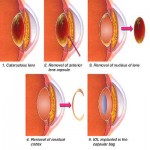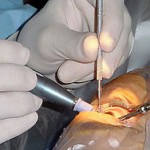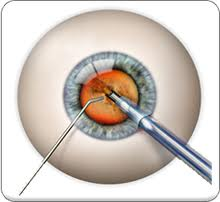Cataract surgery is the removal of the natural lens of the eye (also called “crystalline lens”) that has developed an opacification, which is referred to as a cataract. Metabolic changes of the crystalline lens fibers over time lead to the development of the cataract and loss of transparency, causing impairment or loss of vision. Many patients’ first symptoms are strong glare from lights and small light sources at night, along with reduced acuity at low light levels. During cataract surgery, a patient’s cloudy natural lens is removed and replaced with a synthetic lens to restore the lens’s transparency.
 Following surgical removal of the natural lens, an artificial intraocular lens implant is inserted (eye surgeons say that the lens is “implanted”). Cataract surgery is generally performed by an ophthalmologist (eye surgeon) in an ambulatory (rather than inpatient) setting, in a surgical center or hospital, using local anesthesia (either topical, peribulbar, or retrobulbar), usually causing little or no discomfort to the patient. Well over 90% of operations are successful in restoring useful vision, with a low complication rate. Day care, high volume, minimally invasive, small incision phacoemulsification with quick post-op recovery has become the standard of care in cataract surgery all over the world.
Following surgical removal of the natural lens, an artificial intraocular lens implant is inserted (eye surgeons say that the lens is “implanted”). Cataract surgery is generally performed by an ophthalmologist (eye surgeon) in an ambulatory (rather than inpatient) setting, in a surgical center or hospital, using local anesthesia (either topical, peribulbar, or retrobulbar), usually causing little or no discomfort to the patient. Well over 90% of operations are successful in restoring useful vision, with a low complication rate. Day care, high volume, minimally invasive, small incision phacoemulsification with quick post-op recovery has become the standard of care in cataract surgery all over the world.
Types
Currently, the two main types of cataract surgery extraction performed by the ophthalmologists are phacoemulsification (phaco) and conventional extracapsular cataract extraction (ECCE). In both types of surgery an intraocular lens is usually inserted. Foldable lenses are generally used when phaco is performed while non-foldable lenses are placed following ECCE. The small incision size used in phacoemulsification (2-3mm) often allows “sutureless” wound closure. ECCE utilises a larger wound (10-12mm) and therefore usually requires stitching, although sutureless ECCE is also in use.
Cataract extraction using intracapsular cataract extraction (ICCE) has been superseded by phaco & ECCE, and is rarely performed.
Phacoemulsification is the most commonly performed cataract procedure in the developed world. However, the high cost of a phacoemulsification machine and of the associated disposable equipment means that ECCE remains the most commonly performed procedure in developing countries.
Types of surgery
There are three main types of cataract surgery:
- Phacoemulsification (Phaco) is the preferred  method in most cases. It involves the use of a machine with an ultrasonic handpiece equipped with a titanium or steel tip. The tip vibrates at ultrasonic frequency (40,000 Hz) and the lens material is emulsified.  A second fine instrument (sometimes called a “cracker” or  “chopper”) may be used from a side port to facilitate cracking  or chopping of the nucleus into smaller pieces. Fragmentation into smaller pieces makes emulsification easier, as well as the aspiration of cortical material (soft part of the lens around the nucleus). After phacoemulsification of the lens nucleus and cortical material is completed, a dual irrigation-aspiration (I-A) probe or a bimanual I-A system is used to aspirate out the remaining peripheral cortical material.
- Conventional extracapsular cataract extraction (ECCE): Extracapsular cataract  extraction involves the removal of almost the entire natural lens while the elastic lens capsule (posterior capsule) is left intact to allow implantation of an intraocular lens. It involves manual expression of the lens through a large (usually 10–12 mm) incision made in the cornea or sclera. Although it requires a larger incision and the use of stitches, the conventional method may be indicated for patients with very hard cataracts or other situations in which phacoemulsification is problematic.
- Intracapsular cataract extraction (ICCE) involves the removal of the lens and the  surrounding lens capsule in one piece. The procedure has a relatively high rate of complications due to the large incision required and pressure placed on the vitreous body. It has therefore been largely  superseded and is rarely performed in countries where operating     microscopes and high-technology equipment are readily available.  After lens removal, an artificial plastic lens (an intraocular lens implant) can be placed in either the anterior chamber or sutured into the sulcus.
Cryoextraction is a form of ICCE that freezes the lens with a cryogenic substance such as liquid nitrogen. In this technique, the cataract is extracted through use of a cryoextractor — a cryoprobe whose refrigerated tip adheres to and freezes tissue of the lens, permitting its removal. Although it is now used primarily for the removal of subluxated lenses, it was the favored form of cataract extraction from the late 1960s to the early 1980s.
Intraocular lenses
Intraocular lens implantation: After the removal of the cataract, an intraocular lens (IOL) is usually implanted  into the eye, either through a small incision (1.8 mm to 2.8 mm) using a  foldable IOL, or through an enlarged incision, using a PMMA     (polymethylmethacrylate) lens. The foldable IOL, made of silicone  or acrylic material of appropriate power is folded either using a holder/folder, or a proprietary insertion device provided along with the IOL. The lens implanted is inserted through the incision into the capsular bag within the posterior chamber (in-the-bag implantation). Sometimes, a sulcus implantation (in front or on top of the capsular bag but behind the iris)  may be required because of posterior capsular tears or because of zonulodialysis.
 Implantation of posterior chamber IOL (PCIOL) in patients below 1 year of age is controversial due to rapid ocular growth at this age and the excessive amount of inflammation, which may be very difficult to control. Optical correction in these patients without intraocular lens (aphakic) is usually managed with either special contact lenses or  glasses. Secondary implantation of IOL (placement of a lens implant as a second operation) may be considered later.
Implantation of posterior chamber IOL (PCIOL) in patients below 1 year of age is controversial due to rapid ocular growth at this age and the excessive amount of inflammation, which may be very difficult to control. Optical correction in these patients without intraocular lens (aphakic) is usually managed with either special contact lenses or  glasses. Secondary implantation of IOL (placement of a lens implant as a second operation) may be considered later.
New designs of multifocal intraocular lens are now available. These lenses allow focusing of rays  from distant as well as near objects, working much like bifocal or trifocal eyeglasses. Preoperative patient selection and good counselling  is extremely important to avoid unrealistic expectations and post-operative patient dissatisfaction. Acceptability for these lenses has become better and studies have shown good results in selected patients. Brands in the market include: ReSTOR (R), Rezoom (R) and Tecnis MF (R).

